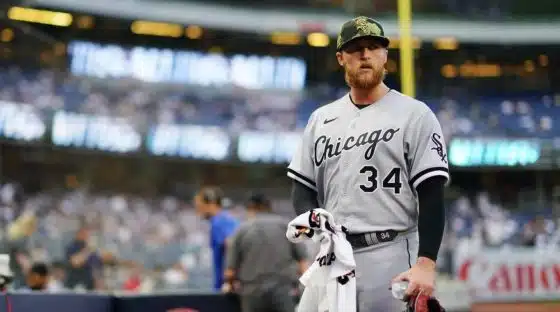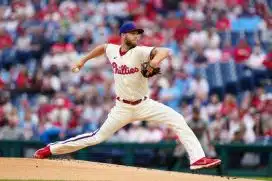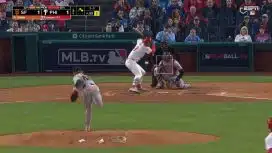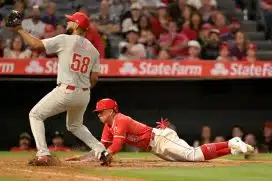By Jason Ferrie, Sports Talk Philly Staff
The Philadelphia Phillies signing of RHP Jake Arrieta isn't a simple thing to evaluate. The signing does bolster the rotation, which consists of young arms with a lot to prove. When the Phillies signed Carlos Santana this offseason, it seemed to signal their intentions to take a step towards competing this season. The Phillies also added Pat Neshek and Tommy Hunter to their bullpen. The last move that needed to be made was pairing Aaron Nola with a veteran arm at the top of the rotation. The Phillies, in theory, attempted to do that with Arrieta, but the level of production the team gets from him is far from a sure thing.
It isn’t news that Arrieta was tremendous with the Chicago Cubs, especially in 2015, where he won the National League Cy Young award. The Phillies are getting a good pitcher, there is no arguing that—but maybe expectations should be tempered heading into his age-32 season.
Arrieta has been one of the most valuable pitchers in baseball over the past several years—posting 18.5 fWAR over the past four seasons in Chicago. However, over the past two seasons, Arrieta has come back down to earth a bit. That should have been expected, though, as his 7.3 fWAR in 2015 is a difficult number to maintain. Since that 2015 season, Arrieta has posted a 3.8 fWAR in 2016 and 2.4 fWAR in 2017. Those are both respectable, but obviously represent a decline. That doesn’t mean Arrieta is done, but it may be a sign that he is now a two-to-three-win pitcher. For a team transitioning toward winning, that adds some value as several arms in the Phillies current rotation project to be replacement level or worse this season.
While projections aren’t always accurate, they do use past seasons to generate their numbers. Arrieta has a larger sample which allows projection systems and experts to generate a relatively sound projection for a player. Here are a few of the projections on what to expect from Arrieta in 2018:
|
Projection |
Starts |
Innings |
K/9 |
BB/9 |
ERA |
FIP |
WAR |
|
Steamer |
31 |
187.0 |
8.62 |
2.95 |
4.10 |
4.03 |
3.3 |
|
ZiPS |
29 |
161.7 |
8.80 |
3.12 |
3.67 |
3.98 |
2.7 |
Again, these are simply projections—but as we can see, they also believe Arrieta is more of a two-to-three-win pitcher now. The positive here is that Arrieta has been durable over the last few seasons, making at least 30 starts in each season since 2015. The Phillies needed a productive veteran that was going to make 30-plus starts along with Nola.
There are the various intangibles and accolades that Arrieta brings to the Phillies, which is something that will be cited in his value by some. He will bring a veteran presence to the clubhouse, one with a wealth of individual and postseason success. With that said, while said leadership may hold value in the clubhouse, it won't change how he will perform on the field over the next few years.
As Arrieta enter his age-32 season, there are some negative trends that he's exhibited that are worth monitoring. For starters, the decline in fastball velocity over the past two seasons is noteworthy. In his 2015 campaign, Arrieta’s average fastball velocity was 94.6 mph. Last season, the average fastball came in at 92.1 mph, which is a big drop for the right-hander.
If Arrieta adjusted and limited hitter success against his most commonly used pitch, the sinker, it wouldn’t be an issue. But that has not been the case with his velocity drop. Below is a table of his sinker usage and resulting outcomes since 2015:
|
Year |
Usage |
Batting Average |
Slugging |
|
2015 |
43.63% |
0.198 |
0.277 |
|
2016 |
59.71% |
0.205 |
0.313 |
|
2017 |
60.22% |
0.251 |
0.428 |
Arrieta has increased his usage of his sinker each year over the past three years. Hitters have also had increasing success against the pitch since 2015.
Arrieta’s regression hasn't been as noticeable against right-handed hitters, though. Each year since 2015, left-handed hitters have had more success against Arrieta—especially his sinker and slider. His sinker, specifically, is his most commonly featured pitch to left-handed hitters.
In 2015, Arrieta featured his sinker to left-handed hitters 42.37-percent of the time and limited them to a .180 batting average, while slugging just .266 against the pitch. The following year, Arrieta featured the sinker 56.25-percent of the time and hitters improved their batting average to .210, while upping their slugging percentage to .355. Although that is still respectable, Arrieta saw the biggest change last season—where left-handed hitters destroyed his sinker. Arrieta featured the pitch 54.53-percent of the time and allowed a .307 batting average and a lofty .534 slugging percentage. It will be important to see if Arrieta can limit left-handed hitters more in 2018.
There are a few other areas that Arrieta to monitor going forward for Arrieta during his time in Philadelphia. Here are the areas of concern with data from 2015 through 2017:
|
Year |
O-Swing % |
Swinging Strike |
Hard Contact |
Fly Ball Rate |
|
2015 |
34.20% |
11.10% |
22.10% |
22.80% |
|
2016 |
29.60% |
10.50% |
25.20% |
27.90% |
|
2017 |
27.90% |
8.70% |
29.40% |
34.40% |
This isn’t to pile on, but these are areas to watch. It will be important for Arrieta to start missing bats again in 2018. His 8.7-percent swinging strike rate in 2017 put him in a tie for 89th of 125 starters to throw 100 or more innings. In terms of getting hitters to chase pitches outside of the zone, Arrieta ended in a tie with Gerrit Cole for 92nd of 125.
If we flash back just two years prior, Arrieta drew the 14th most swings at pitches out of the zone. Along with that, Arrieta’s swinging strike rate was tied with Garrett Richards at 24th best. While this was obviously Arrieta’s peak season, it does show the change we’ve seen the last few seasons.
As Major League Baseball becomes more conscious of launch angles and the success that comes with them, it will be interesting to see whether his fly ball rate continues to trend up. In his Cy Young season, Arrieta produced the seventh best groundball rate of starters in baseball. Last season he fell closer to the middle-of-the-pack at 65th of 125 starters. The fly ball rate across baseball has risen each of the last three seasons along with the home run to fly ball rate.
Arrieta is still a good pitcher and is an upgrade for the team, but there are some things to keep an eye on as he enters his first year as a member of the Phillies. Arrieta does get a park upgrade going from Chicago to Philadelphia—but the decline in velocity, missed bats and increased hard contact is something to monitor.






